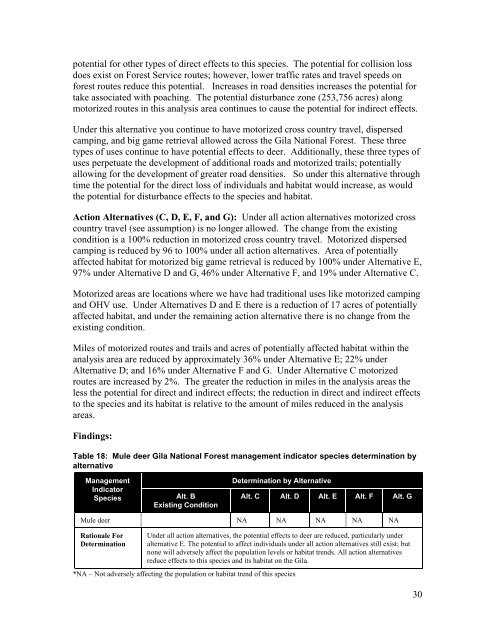Wildlife Specialist report
Wildlife Specialist report
Wildlife Specialist report
Create successful ePaper yourself
Turn your PDF publications into a flip-book with our unique Google optimized e-Paper software.
potential for other types of direct effects to this species. The potential for collision loss<br />
does exist on Forest Service routes; however, lower traffic rates and travel speeds on<br />
forest routes reduce this potential. Increases in road densities increases the potential for<br />
take associated with poaching. The potential disturbance zone (253,756 acres) along<br />
motorized routes in this analysis area continues to cause the potential for indirect effects.<br />
Under this alternative you continue to have motorized cross country travel, dispersed<br />
camping, and big game retrieval allowed across the Gila National Forest. These three<br />
types of uses continue to have potential effects to deer. Additionally, these three types of<br />
uses perpetuate the development of additional roads and motorized trails; potentially<br />
allowing for the development of greater road densities. So under this alternative through<br />
time the potential for the direct loss of individuals and habitat would increase, as would<br />
the potential for disturbance effects to the species and habitat.<br />
Action Alternatives (C, D, E, F, and G): Under all action alternatives motorized cross<br />
country travel (see assumption) is no longer allowed. The change from the existing<br />
condition is a 100% reduction in motorized cross country travel. Motorized dispersed<br />
camping is reduced by 96 to 100% under all action alternatives. Area of potentially<br />
affected habitat for motorized big game retrieval is reduced by 100% under Alternative E,<br />
97% under Alternative D and G, 46% under Alternative F, and 19% under Alternative C.<br />
Motorized areas are locations where we have had traditional uses like motorized camping<br />
and OHV use. Under Alternatives D and E there is a reduction of 17 acres of potentially<br />
affected habitat, and under the remaining action alternative there is no change from the<br />
existing condition.<br />
Miles of motorized routes and trails and acres of potentially affected habitat within the<br />
analysis area are reduced by approximately 36% under Alternative E; 22% under<br />
Alternative D; and 16% under Alternative F and G. Under Alternative C motorized<br />
routes are increased by 2%. The greater the reduction in miles in the analysis areas the<br />
less the potential for direct and indirect effects; the reduction in direct and indirect effects<br />
to the species and its habitat is relative to the amount of miles reduced in the analysis<br />
areas.<br />
Findings:<br />
Table 18: Mule deer Gila National Forest management indicator species determination by<br />
alternative<br />
Management<br />
Indicator<br />
Species<br />
Alt. B<br />
Existing Condition<br />
Determination by Alternative<br />
Alt. C Alt. D Alt. E Alt. F Alt. G<br />
Mule deer NA NA NA NA NA<br />
Rationale For<br />
Determination<br />
Under all action alternatives, the potential effects to deer are reduced, particularly under<br />
alternative E. The potential to affect individuals under all action alternatives still exist; but<br />
none will adversely affect the population levels or habitat trends. All action alternatives<br />
reduce effects to this species and its habitat on the Gila.<br />
*NA – Not adversely affecting the population or habitat trend of this species<br />
30
















